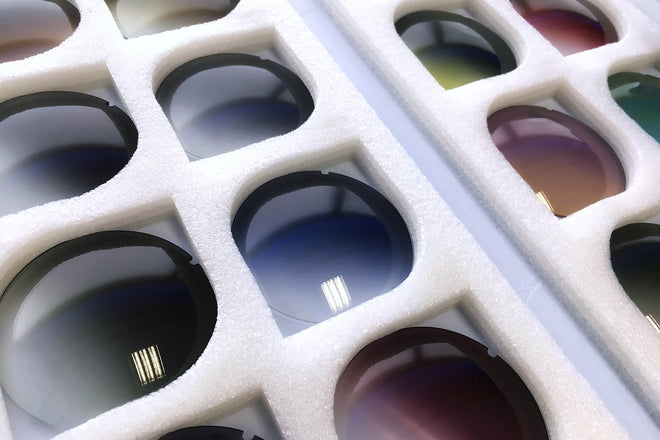From gray and brown to yellow and pink, there are many fashionable lens colors to choose from for your sunglasses. But did you know that each color offers a different benefit?
That’s right. Each color serves a specific purpose to help make sunny days more enjoyable! From sports and leisure to road trips and boating, this sunglass lens guide will help you decide which color is right for your lifestyle.
Polarized Lenses
Typically light bounces off an object’s uneven surface and scatters. However, if the surface is smooth like a calm lake or a freshly coated mountain slope, the light reflects at a single angle and sometimes directly into your eyes and creates glare. Read more about polarized sunglasses and how they work.
If you are looking to reduce sun glare and reflection while on the water or the slopes, then polarized lenses are for you. Polarized lenses can increase visual clarity and protect your eyes from damaging UV rays. Shop Polarized Lenses
Mirrored Coatings
Mirrored coatings help prevent eye fatigue and reduce glare. The look is ultra-sleek and comes in many colors. The coating decreases the amount of light passing through the tinted lens by 10-60%.
Gray Lenses
When it comes to blocking out the sun’s rays, nothing is better than gray lenses. They decrease the sun’s brightness and glare, but they don’t alter the other colors like the green grass or the blue skies.
Gray lenses also decrease eye strain on sunny days since your eyes don’t get exposed to overwhelming amounts of glare.
If you live in a primarily sunny place, gray lenses are the way to go and the best option to protect your eyes from too much light and prevent excessive eye strain and discomfort. They can also be great for trips where sun exposure is a concern, such as for skiing or for outdoor adventures in hot climates.
Gray Lens Overview
- Great for general use
- Driving
- Sports
- Water sports
- Anti-fatigue
- True color
- Sunny or overcast days
Brown Lenses
If you want a good all-around pair of sunglasses or can only take one pair on a trip, then brown lenses are a good choice. They are not as good as gray lenses when it comes to blocking sunlight, but they do an excellent job while increasing contrast, clarity, and depth perception by filtering out blue light.
Blue light is harmful to your eyes and also obscures what you see by creating glare
I use my brown lenses for biking, trekking, and water sports since it increases contrast and perception, which is excellent for seeing what’s in front of me when I’m going at a good pace.
So, if you want just one versatile pair of sunglasses for a variety of different conditions, brown lenses would be an excellent choice.
Brown Lens Overview
- Increases contrast, clarity, and depth perception
- Biking
- Water sports
Green Lenses
Green lenses are suitable for general purpose wear since they decrease eye strain by blocking out blue light. They also enhance perception by providing good contrast for low-light conditions. Also, they increase contrast while preserving the color of what you see.
However, they are not suitable for use in sunny conditions.
I use my green-colored sunglasses for tennis, volleyball, or when I need to track a fast-moving object such as a tennis ball or softball against a different colored background like grass. It doesn’t reduce brightness as much as brown or gray, but its ability to enhance contrast makes it excellent for sports.
So, if you’re looking for good lenses for daily use that enhance contrast while not altering the color of the outdoors, green would be a perfect choice.
Green Lens Overview
- Decreases eye strain
- Reduces blue light
- Enhances contrast in low-light conditions
- Tennis, volleyball, softball
Yellow Lenses
Yellow lenses are gaining popularity because they are among the best choices for bringing in more light in hazy or low-light conditions. They also do an excellent job minimizing blue light, so they are perfect for looking at digital screens to help prevent glare and eye strain. However, they are not the lens of choice for bright days like brown or gray lenses.
Yellow lenses are my favorite choice when I’m riding my scooter at dusk or nightfall or when I’m typing on my computer for long periods.
These lenses are good when it’s a cloudy, overcast day, and you want a little bit more clarity with what you’re seeing. They’re better for low light conditions than green lenses, which are better for contrast. Overall, it’s good to have yellow lenses in your sunglass collection because it fills a niche that the other colors can’t.
Yellow Lens Overview
- Great for hazy or low-light conditions
- Reduce blue light
- Excellent for digital device use
- Great for driving at dusk or nightfall
- Cloud or overcast days
- Skiing, hunting, aviation, target shooting
Blue Lenses
Blue sunglasses lenses are great for UV protection. While sometimes referred to as purple lenses, the tint enhances the contours around objects while improving color perception. These glasses are great for water sports, snowy conditions, and golfing.
Blue Lens Overview
- Reduces glare
- Enhances colors and contours
- Winter sports, golfing
Red/Pink Lenses
Red lenses, or pink lenses, allow the eyes to adjust to contrast. Winter athletes are usually seen wearing these types of lenses due to their ability to enhance visual depth in snow. Additionally, red lenses are great for driving and gaming.
Red Lens Overview
- Reduces eye strain
- Enhances visual depth
- Increase road visibility
- Great for winter sports like skiing or snowboarding
Which color lens is right for you?
As you can see, each lens is suitable for different reasons depending on your environment, activity, or even your particular glare or light sensitivity.
Overall, gray or brown lenses would be a good choice for when you want just one pair that does it all. Green is great for contrast and general purpose. Yellow lenses would be suitable, especially for low light or using computer/laptop/smartphone screens.
Whatever you choose, you are helping your eyes feel more comfortable, reducing eye strain and promoting your eye health by choosing to put on sunglasses when going outdoors.












